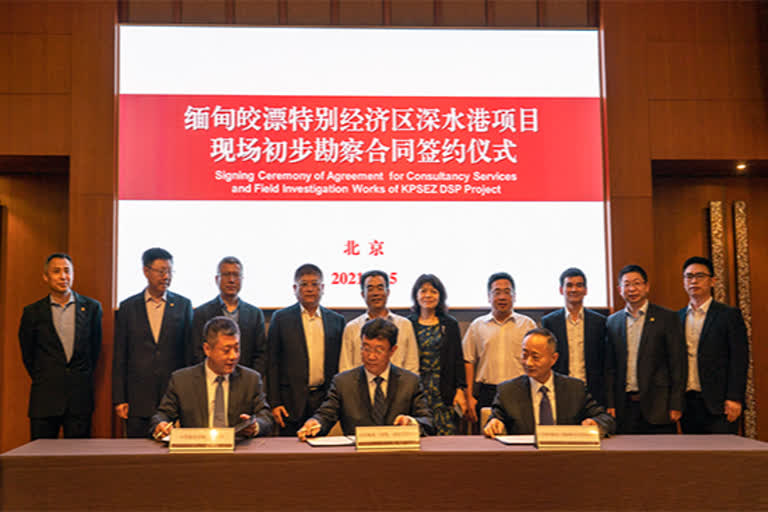New Delhi: After developing seaports cum Special Economic Zones (SEZ) in Hambantota in Sri Lanka and Gwadar in Pakistan’s Balochistan, China is racing ahead to build its third seaport cum SEZ in India’s neighbourhood at Kyaukphyu in Myanmar, in yet another significant progress of Chinese plans to access the Indian Ocean.
On Wednesday (September 15, 2021), an agreement was inked in Beijing to begin the preliminary field investigation and consultancy work for the Kyaukphyu SEZ Deep Sea Port Project (KPSEZ DSP Project).
A company communiqué said: “This signals an important step in joint development of the KPSEZ DSP Project by Myanmar and CITIC Consortium.”
“CITIC Consortium Myanmar Port Investment Limited, as the client, signed the Agreement with the successful bidder, a consortium composed by CITIC Construction and CCCC FHDI, a subsidiary of China Communication Construction Company.”
“The CITIC Construction - CCCC FHDI consortium ranks the first among all the bidders and is awarded the bid”, it added.
CITIC (China International Trust and Investment Corporation Group) is the main developer of the project which has profound strategic implications.
Under China’s ambitious Belt and Road Initiative (BRI), Kyaukphyu, located in Myanmar’s restive Rakhine state off the Bay of Bengal, would be connected by rail to Kunming in China’s southwestern Yunnan province.
Also read:China opens up another route to Indian Ocean via Myanmar
Already a 770-km-long parallel oil and gas pipeline runs from Kyaukphyu to Ruili in Yunnan province and later extends to Guangxi after a 2,800-km-long run.
Besides the plan to become a trade hub for Chinese exports and imports via the sea, the 4,300-acre KPSEZ DSP project aims to become a centre of electronics, textile and garments, food processing, pharmaceuticals, marine supplies, and research.
The KPSEZ DSP project forms part of China’s BRI effort in western Myanmar and is the flagship project of the proposed China-Myanmar Economic Corridor (CMEC).
BRI aims to connect 70 countries across the globe through road, sea and rail connectivity infrastructure projects.
Conceptualised in 2015, China and Myanmar signed the concession and shareholders’ agreements for the deep seaport during Chinese President Xi Jinping’s trip to Myanmar in January 2020. On completion, the project will be jointly operated.
Initially envisioned as a $9 billion project, the two sides agreed to water it down to a $1.5 billion project in the first phase with China trying to assuage concerns that it was leading Myanmar to fall prey to China’s “debt-trap” diplomacy.
Interestingly, in a sign of the speed at which China is developing infrastructure projects that open up to the Indian Ocean, on August 26, 2021, China inaugurated a vital rail that connected the commercial and military nub of Chengdu to the border town of Lincang, located just opposite the border town of Chin Shwe Haw, in Myanmar’s Shan State, virtually completing a sea-road-rail link that connects Singapore to Chengdu.
Also read:Afghanistan not to join talks on INSTC, Chabahar port
Besides shortening the shipping time from Singapore to Chengdu by a good 20 days, the new link will enable China to carry out international trade directly from the Indian Ocean onwards with West Asia, Europe and the Atlantic region.
These connectivity projects to the sea are aimed at overcoming what is termed as China’s “Malacca Dilemma” or the unavoidable route that Chinese ships have to take through the narrow Malacca Straits which has the potential of being a ‘choking point’ for Chinese ships during times of hostility.
